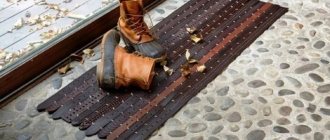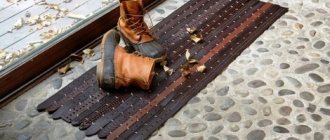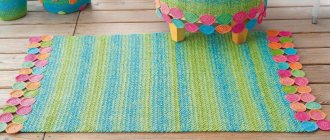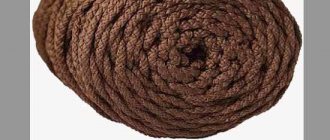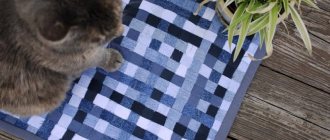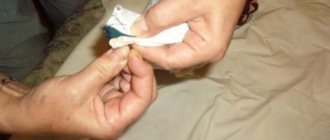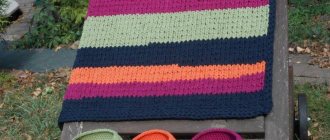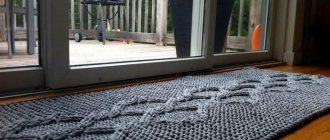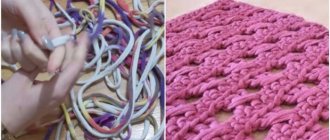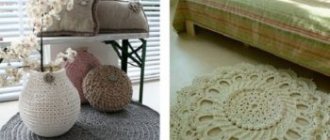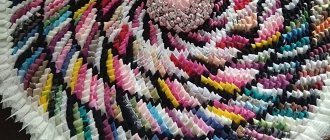It would seem, how can an ordinary small rug change the interior? But it turns out that it can become not only useful, but also a bright, interesting detail in interior design. Of course, you can buy it in a store, fortunately, now there are rugs for every taste and color. But think how nice it will be when you make it yourself, especially since such a rug can be easily made from old things, for example: threads, fabrics, wine corks, belts, and much more. All you need is to know the step-by-step instructions, stock up on the necessary materials and patience.
Rug made from old leather belts
Making a mat from belts is very simple.
For this you will need:
- 10-12 natural or faux leather belts
- awl or leather punch
- twine or string.
First make the belts the same length by cutting off the buckle. Make holes along the edges of the straps at a distance of approximately 2-3 cm from each other and 0.5 cm from the edge. Sew them together using thin hemp rope. The order of pulling the rope is arbitrary; you can sew along the belts, across, crosswise between the holes. Metal staples instead of rope will also look very stylish.
Soft rug made from old fabrics
Required material:
- scissors
- pieces of old (unnecessary) fabrics, maybe old clothes
- bath mat (with holes)
1. Cut the fabric into small strips
2. Using tweezers or a hook, begin pushing the strips through the holes.
3. Tie all fabric strips with a simple knot.
Patchwork
Although the name of this method appeared relatively recently, blankets sewn using this technology can be seen in any village house.
To get a beautiful carpet, you must follow the instructions exactly:
- Fabric preparation. It is advisable to take bright and beautiful pieces.
- If the fabric is old, then it needs to be ironed thoroughly.
- To ensure that the finished product does not deteriorate ahead of time, you should prepare the base and padding (batting or construction foam).
- Cut the prepared fabric into pieces of the same size, taking into account allowances.
- The flaps are laid out according to a pre-selected pattern. For the first time, it is better to choose a simple pattern.
- To give the finished product softness and volume, a spacer is placed between the base and the top fabric.
Patchwork
Making a rug from old towels
Required material:
- old towels
- scissors
- sewing machine (needle and thread)
1. Cut your towels into several strips. In this example, each strip is about 3 - 4 cm wide.
For convenience, you can fold each towel in half and cut it into 2 halves. Fold each half in half again and cut along the fold line, etc. It is advisable that all towels are approximately the same size.
2. Place 3 strips of different colors together and secure them with thread (stitch the ends). Start braiding these strips. After finishing the weaving, stitch the ends again.
3. Make several of these “braids” and then connect them into one long strip using a needle and thread (or a sewing machine).
4. Start rolling your long strip into a spiral, securing it with a thick thread.
5. Secure the entire structure and turn it over so that the seams are on the bottom.
Your rug is ready!
Preparation of material
In home knitting, weaving, weaving, narrow strips are used, cut from outdated clothes, bedding, unnecessary scraps; any raw material will go into business and find its application. A rug made of knitwear or fine wool will be soft, warm, it is good for a nursery or bedroom, a harder texture is appropriate in the hallway, and a mat that absorbs moisture is more suitable for the bathroom.
Old sheets and towels are convenient; they are easier to cut into strips. First of all, clothes need to be rid of unnecessary details: cut off the top of a T-shirt above the armholes, cut off the belt, pockets, and rough seams from jeans. Wrinkled items must be ironed before processing. The thickness of the future product depends on the width of the cut.
If the tapes are too short, they are connected to each other. It is not recommended to tie with knots, it is inconvenient to work with and looks sloppy. In order for rag rugs to have an aesthetic appearance, the connection must be inconspicuous.
Stitching with a needle takes a lot of time, but there is an excellent technique: cut slits at the places to be joined, lay one on top of the other, thread the end of the strip into the common hole and pull it out.
Wine cork rug
Wine bottle corks are an excellent material for a variety of crafts for the home and garden. One useful option is to make your own cork mat. Cork bark practically does not absorb moisture and bacteria do not multiply in it, which is why cork is excellent for rooms with high humidity, that is, for the bathroom. And walking on a mat of traffic jams is not only very pleasant, but also useful!
To make a small rug, you will need:
- 150-180 wine corks;
- glue;
- a piece of water-repellent material for the base (rubber shower or yoga mat, rubberized fabric, soft thin plastic);
- sharp knife;
- coarse sandpaper;
- cutting board.
1. Assemble and prepare the plugs. If you do not have the required quantity, you can buy plugs in online stores. Wash them thoroughly in warm soapy water. To remove red wine stains, soak the corks in a bleach solution and leave them overnight. Then rinse well and leave to dry.
2. Cut each cork lengthwise into two pieces. Use a cutting board and a sharp knife. If the cuts are very uneven, smooth the edges with sandpaper. For convenience and safety, it is better to cut the cork not on its side, but by placing it in a vertical position.
3. Place the corks with the cuts down on the table as they will be located on the rug, decide on the size of the future rug. Then cut the base of the rubber material to the desired size. You can come up with a pattern yourself, it can be a checkerboard pattern, even rows, zigzags.
4. Start gluing the corks to the base with an adhesive suitable for gluing such surfaces. Glue the corks around the perimeter first, then moving towards the center. Remove excess glue immediately with a cloth.
The cork mat must dry completely. To make it completely waterproof, you can treat the surface with a sealant. If you use a cork mat in the bathroom, it is advisable to dry it in the sun at least once a month for prevention.
Strip technique
A distinctive feature of such patchwork rugs is the pattern assembled from stripes. There are also several design options.
- “Stripe to stripe.” In such a product, rectangular flaps are placed parallel to each other.
- "Bargello". The pattern is made up of stripes that are shifted relative to each other. The result is something like brickwork.
- "Log Cabin" This technique is one of the most interesting. Here the stripes are placed in a spiral, and the center is a small square.
Rug woven from shreds
Materials needed for making it yourself:
- thick fabric (carpet base)
- pieces of fabric
- black thread
- needle
- scissors
- fabric glue
- adhesive tape
- spray for protective coating (if desired)
1. Select the size of the carpet and prepare a cloth of the appropriate size.
2. Prepare long strips of fabric. Each strip should be approximately 6-7 cm longer than the main part of the carpet.
3. Prepare several bundles of 3 strips and start braiding. You need several blanks so that you can combine them into one carpet. For convenience, secure the ends of each piece with adhesive tape. Don't weave all the way through - leave some of the fabric unwoven.
4. Apply glue to a thick canvas. No need to skimp on glue.
5. Carefully place the blanks on the canvas so that they stick.
6. Connect all the pieces together using a needle and thread.
7. Remove the duct tape from the ends. Trim the ends so they are even.
The rug is ready!
Square technique
Making rugs in patchwork style using the square technique can be called the simplest. This option is worth exploring for beginning craftswomen. The main difference is that the fabric is stitched from identical squares (they, in turn, can be made up of stripes).
The list of the most common ornaments in the square technique includes:
- “checkerboard” - in this case, all the squares are arranged in a checkerboard pattern, which makes it possible to successfully combine dark and light patches;
- “Russian square”;
- “quick squares”.
DIY pompom rug: Option No. 1
Required material:
- wool thread
- scissors
- bath mat (with holes)
1. Wrap the wool thread around your fingers (the more you wrap, the fluffier the pompom will be).
2. Carefully remove the wound thread from your fingers. Prepare another short thread - about 20 cm long - and tie it around the wound thread (in the middle).
3. Cut off the ends with sharp scissors. Also cut off the excess parts with scissors to get a neat round pompom. But don't cut the thread you used to tie the pompom, you'll need it later.
4. Make enough pom poms to cover the bath mat. After this, begin to thread the thread through the holes and tie it to the rug, thereby attaching the pom poms to the rug. The pompoms should be close to each other.
5. When you have tied all the pompoms to the carpet, you can cut off the ends of the threads.
Your DIY pompom rug is ready!
Simple patchwork for beginners
At first, to master the techniques, it is better to perform a simple example.
Usually the question does not arise of how to sew a rug from scraps if they are cut into identical rectangles or squares. Such parts are sewn into strips, which are then easily combined into a fabric if they are arranged in parallel or in a more complex order. A popular technique is to form an ornament of long and short colored ribbons on the sides of a rectangle located in the center. A bright, motley picture is obtained from triangles. It is not difficult to simplify their shape for further work: if you connect them with long sides, you get a square, and if you connect them with short sides, then a strip.
Having learned to make simple rugs from scraps of fabric with their own hands, and over time, having gained experience, many passionate craftswomen create luxurious original works, real works of art.
Simple pompom rug: Option No. 2
To make this blue and white pompom rug, you will need:
- thick woolen threads for knitting;
- mesh base for the rug;
- scissors.
1. Make pom-poms in different colors to create a smooth gradient color transition. You can make a plain rug or lay out a specific pattern. You can also play with the size of the pompoms, using large, smaller and very small ones. To do this, look here for the best way to make pompoms of different sizes.
2. Now tie each pompom to the net, following the color scheme. Try not to see the outline between the pom-poms.
If desired, the back side of the rug with knots can be covered with fabric or knitting so that the pompom rug is beautiful from all sides, even from the inside out. If you couldn’t find a suitable base - a mesh - it doesn’t matter, pompoms can simply be sewn to any fabric.
Unusual carpets. Photo
A carpet in the shape of a fried egg, created by Italian designer Valentina Audrito, was presented at a Milan interior decoration exhibition. Visitors to the exhibition took great pleasure in lying on the squirrels, resting their heads on the yolk.
And the German creatives from the Flachbild studio came up with carpets in the form of a piece (a piece with a diameter of 1 to 5 meters) of different types of sausage: from amateur to salami. The carpets are made from pure wool.
Designers use a variety of materials to realize their ideas.
Felt and felt are especially valued for their practicality.
Norwegian designer Ksenia Mavafagh imagined a carpet in the shape of stonework. These pebbles are made from felted felt.
You can make bright, multi-colored rugs from functional felt by connecting the parts with a zipper. And it’s convenient to wash this one in parts.
You can also make a carpet in the shape of a pack of colored pencils.
There are even leather carpets. Here, for example, is a design idea from an Italian company. All leather elements of this carpet are hand-joined into a single whole.
Rachel Denny from the USA decided to use ordinary women's gloves for an unusual carpet.
And this is the fantasy of ordinary people: a carpet made of socks. I hope it's new.
Unusual carpets and rugs can be made from old jeans. In the photo shown, the carpet is made of only jeans labels. They are machine sewn onto denim or sewn together by hand.
Twine has become a particularly popular material for carpets and rugs. And not just rugs. I crocheted a box from twine. It turned out interesting.
There is no need to knit a carpet from twine. The cord is twisted in parts into large and small rings or other shapes and glued to a solid base in a certain order.
But that is not all! Even tree cuttings can serve as material for carpets.
And the Dutch designer Yvette Laduc came up with a carpet that imitates the cut of a tree tree. This unusual carpet is made of soft fleecy material and fits perfectly into a modern interior.
Here are more ideas for wool carpets:
- in the shape of the moon, created by designer Martin Mostbeck for the 40th anniversary of the astronaut landing on the moon,
- and a rectangular carpet with a perforated effect.
By the way, I came up with the idea of making such an interesting, unusual rug with my own hands: crocheting it! One part is made with single crochets, and the second part is made of openwork motifs. We have a selection of square motif patterns.
If you remember, I recently talked about how to make an original wall panel by cross-stitching on a perforated panel with large stitches. Using the same embroidery technique you can make a beautiful carpet for the floor.
Rugs of unusual shape
In addition to the usual round and rectangular ones, you can make rugs of unusual shapes, absolutely any, like these blots.
Crochet in short rows is used here. For example, we knit several rounds, then some in reverse rows, again in the round, and so on. The shape of the rug can be completely unexpected.
You can also crochet unusual rugs in the shape of a butterfly or an Irish paisley cucumber, or anything at all, using patterns and thick yarn.
Owl or foot shaped rugs are a great idea for unusual bath rugs.
I am attaching the diagrams.
Round foot mat made with a hoop
Old knitted T-shirts are actively used by craftswomen for a variety of crafts; in particular, the idea of making rugs out of them is very popular.
Necessary materials:
- 3-4 T-shirts (other things, ribbons or ropes)
- children's gymnastic hoop or hula hoop for adults scissors
It is recommended to take items made of fabric with a minimal admixture of elastane, tape or just rope.
The size of the mat depends on the size of the chosen hoop; you can take either your daughter’s gymnastics hoop or a large weight loss hoop. The weaving technology is very simple; even a child can do it by making a round rug on a hoop for their room.
Cut T-shirts or other old outerwear into strips of equal width, from one side seam to the other, to form rings. Place each strip on the hoop: first a vertical line, then a horizontal one, and then divide each sector into equal parts with a strip of a T-shirt.
Important! The strips of fabric should not be very stretched, otherwise the finished rug will wrinkle and will not hold its shape. Ideally, the T-shirt strip should fit almost loosely over the hoop, with minimal stretching of the fabric.
It's likely that if the diameter of your hoop is larger than the t-shirt strip, it's too tight or you're using ropes at all. In this case, simply wrap the hoop in fabric or rope and tie a knot.
Try to have all the base lines intersect at the center point. We start weaving the rug from the center. Take a strip of T-shirt, fasten it with a loop to one of the warp lines and pass it under and over the longitudinal lines.
When the strip ends, tie another T-shirt ring to it, hiding the knot under the previous row. Continue weaving in the same way, alternating between pulling the strip under and over the longitudinal lines. Try to keep each circle pressed tightly against the previous one, avoiding large spaces or holes between them. Once you have finished weaving, cut off the ends of the loops with scissors and tie them with a knot.
Types of patchwork
All patchwork rugs are made according to the same principle - they are sewn together from separate patches. Despite this, execution styles vary significantly.
- Classic style (also often called English). This product is a carpet sewn from square patches of the same size. In this case, fabrics are chosen that are similar in texture and color. The result is a laconic and easy-to-understand carpet, suitable for placement in almost any interior.
- Crazy (crazy). The exact translation of this word from English means “mad” or “crazy.” You can recognize a product in this style by patches of various irregular shapes. One carpet can organically combine geometric shapes, drop-shaped, wavy and any other pieces of fabric. In this case, the texture and color of the material are often chosen differently. Such a carpet can well be called a work of art, and the master has no restrictions.
Illuminated rug
Sometimes at night you want to go to the toilet, go to the kitchen to eat, drink a glass of water or prepare a bottle of formula for the baby, so you have to get up and leave the bedroom. In the dark, and even in a half-asleep state, there is a risk of bumping into something, and turning on the overhead light is not always possible so as not to wake up other family members. For such cases, LED floor lighting in a rug will be an interesting and useful solution.
Craftswoman Johanna Hyrkas came up with the great idea of using an LED strip as a lighting sign for the way out of the bedroom. The ribbon is twisted in a spiral, located inside a round rug woven from ordinary rope, and a long tail leads further from the room. Soft, cozy light spreads across the floor without disturbing sleep.
Such a rug with LED lighting can serve as a night light in a child’s room. In addition, a strip of rug can be laid along the walls and lead to the toilet or kitchen. For such purposes, it is better to use a sealed closed LED strip. You can make a rug with your own hands, using a large crochet hook or using your fingers to braid a ribbon with thick yarn or rope. Of course, there are expensive models of LED floor lighting with a light power control. But often the homemade option is an excellent budget solution, as in this case.
A fun and useful hobby
There are many ways to make them; accordingly, these items are infinitely varied and can take their rightful place in any part of the apartment, in the hallway or in the kitchen, in the nursery, bedroom, living room. Beginners should not be embarrassed by the lack of skills; many of the techniques are quite simple, the work is fascinating, and step-by-step instructions and many ideas suggested by the masters will help overcome difficulties.
The peculiarity of homemade rugs is that, as a rule, “waste” material is used to create them, thus, savings and recycling of unnecessary things become by-products of creativity.
Rug made from jeans labels
The concept of using clothing items for other purposes after they have been worn out is not new. For decades, women have been making patchwork rugs and quilts from old items. In the same way, you can make a carpet with your own hands from labels from jeans. The only problem is finding enough labels, because even for a small rug you will need at least 50 pieces.
To make such carpets with your own hands, it is better to sew labels onto some kind of fabric, maybe even thin. Labels sewn on each other will give the carpet the necessary density. For work, use a sewing machine, since manually sewing each label is a very labor-intensive task. Make stitches around the perimeter of the label, where it was sewn to the jeans. You can choose the pattern yourself - the correct even mesh, herringbone, spiral for a round carpet, but labels in a slightly irregular order, sewn on top of each other, look most impressive.
Patchwork - a classic of patchwork creativity
Making a patchwork rug requires a more careful selection of materials, and if a complex item is conceived, then considerable skill. This is the same technique used to make the famous “granny” quilts.
Since the product is intended for the floor, the fabric chosen is dense: denim, gabardine, drape or tweed from an old coat. You will need a lining made of solid fabric, also strong. If you have worn-out carpet, it will make an excellent base.
The design of the item needs to be thought out in advance, a combination of colors should be carefully selected, preferably bright ones, and one of the many designs developed in this area should be taken as a model. It is useful to familiarize yourself with what has been created by experienced craftsmen.
Many of the author's mosaic items are complex, exquisite, practically a master class. You will have to sew both by hand and by machine, because the amount of work is large.
To assemble a kind of mosaic, which is a rug made from scraps of fabric using the patchwork technique, first take into account all types of elements that make up the selected ornament. A paper template is made for each of them. To make and work with them, use:
- scissors;
- paper or cardboard;
- pencils;
- fabric chalk;
- pins.
Using templates, cut out the required number of parts, leaving seam allowances. Referring to the image of the finished product or your own conceived pattern, the ornament is laid out, sewn by hand, then by machine, ironing each seam.
How to make a rug "French bracelet"
Required material:
- old fabric of 2 colors (you can use old T-shirts). The width of each piece of fabric is 20-25 cm and the length is 3 meters. If you are using old T-shirts, you can join several pieces together with a thread and a needle.
- scissors
- needle and thread
- adhesive tape
1. Arrange 5 strips of different colors in the order in which you want them to look on the future carpet.
2. Next to the 5 laid out strips, place another 5 strips in a mirror image.
3. Take the first strip, in this case the pink one, and tie it as shown in the image. First, fold the fabric to form a number 4.
4. Continue tying the pink strip around the remaining strips until you reach the middle.
5. Start doing the same on the opposite side, tying another pink stripe around the other 4 stripes. Start also with the number 4, but in a mirror image.
6. When the two pink stripes meet in the middle, tie them together.
7. Repeat the same with the subsequent remaining strips. Choose the length of the rug yourself.
8. Start another rug, choosing the same colors. After this, connect both rugs with thread and needle.
Tip: If you wish, you can make one or more similar rugs, which can then be sewn into one large rug.
9. Excess parts can be cut off and the ends secured with thread to prevent them from unraveling.
